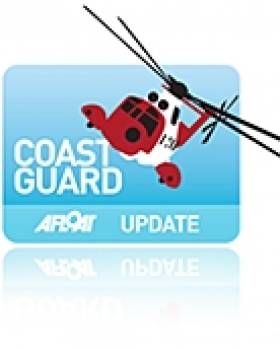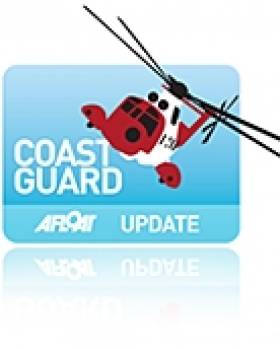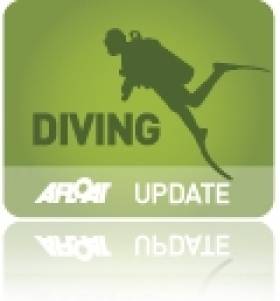Displaying items by tag: helicopter
Eye Witnesses to Low Flying Helicopter on Kerry Beach Question Closure of Investigation
Eyewitnesses to an incident where a helicopter cruised at low level in thick fog across a popular Kerry beach have questioned why the Irish Aviation Authority (IAA) is not pursuing it further.
Video footage of the incident shows the helicopter an EC (Eurocopter) 155 - flying through fog along the shoreline at around ten metres (33 ft) with no lights, against aviation rules.
The incident on August 27th was reported to the IAA, which says it believes the helicopter was operated in an “appropriate manner” in “unexpected conditions”.
“Someone could have been killed, and we are just lucky that we got out of the way in time,” John Jeffers, one of the witnesses who filmed the incident, has said.
Jeffers and his wife Kathleen from Ardfert, Co Kerry were walking their two dogs along nearby Banna strand in Co Kerry at around 6.30 pm that evening.
The couple had decided to leave the beach due to the fog, when they heard a roaring sound which they described as “louder than a tractor”.
“As it got louder, and the ground seemed to vibrate, we quickly realised that it was heading in our path,” Jeffers said.
“We ran to the sand dunes, and within seconds this black helicopter appeared which was only visible within 150 metres,” Jeffers said.
The aircraft flew south over the beach’s main carpark from Ballyheigue in the direction of Barrow. A number of people in the car park nearby also witnessed the incident.
“It was so close to us that Kathleen could see the sole pilot in the cockpit,” Jeffers said.
An aviation expert who viewed the video said that it was an “extremely dangerous manoeuvre”, where the aircraft was clearly cruising and using the shoreline to navigate in fog.
“Aircraft must have navigation lights on, as in green and red on each side and a white tail light, and a flashing anti-collision light at all times,” the expert, who did not wish to be named, said.
“The video footage clearly shows no lights,” he said. The registration of the aircraft was not visible on the footage.
The IAA, which is the State regulator on aviation, said the “footage in question” was reported through the European Co-ordination centre for Accident and Incident Reporting Systems, a European aviation safety portal.
“As the competent authority, the IAA has investigated the occurrence, and engaged with the operator of the helicopter to ensure that the safety of the public was not compromised in the normal course of operations,” an IAA spokesman said.
Latest news from Banna Beach, Ardfert, County Kerry. My brother in law thought a tractor was coming along the beach while out walking the dog and it turned out to be a helicopter ?. He reckons the pilot was using the beach as a guide because of the fog that came from nowhere (forgive his language ?).
Posted by Ned Kelly on Friday, August 27, 2021
“We are satisfied that the helicopter was operated in an appropriate manner under the unexpected conditions encountered,” the spokesman said, confirming the investigation had “closed” late this week.
The Jeffers couple said they were not contacted by any investigation team, and expressed surprise that the investigation had closed so early.
The IAA did not respond when asked to comment further.
The EC 155 is a twin-engined aircraft which can carry up to 13 passengers, along with crew, and was developed for civil aviation use.
Shannon Coast Guard Helicopter Rescues Spanish Trawler Man
The Shannon Coast Guard helicopter has medevac'ed a Spanish crewman from a trawler 120 nautical miles SSW of Mizen Head, in County Cork, one of the extreme points of the island of Ireland.
Irish Coast Guard Helicopter Missions Reach 1,000 For First Time In 2015
#Coastguard - Two callouts on St Stephen's Day brought the Irish Coast Guard's total annual helicopter rescue missions to the 1,000 mark for the first time since the service began in 1991, as RTÉ News reports.
Sligo's Rescue 118 had its 343rd mission of the year on Saturday 26 December when it airlifted a young boy with leg injuries, while the Shannon-based Rescue 115 was involved in a medevac from the Aran Islands, taking a pregnant woman to Galway University Hospital for its 330th response.
In the East, the coastguard crew of Waterford's Rescue 117 saw 179 missions this year, while Dublin's Rescue 116 embarked on 148 since January as of yesterday (Sunday 27 December).
RTÉ News has more on the story HERE.
Helicopter Salvages Yacht off Beach
#solosailing – It seems there's nothing a helicopter can't handle in terms of recovery, even in a worst case scenario like the one above.This successful salvage lift of a Pogo 2 Mini 6.50 was completed at Bovisands beach on the east side of Plymouth Sound in Devon, England. That's a 430 kilogram keel too!
Three Bodies Recovered in Shetlands Helicopter Crash
#RNLI - Three bodies have been recovered from the water after a helicopter with 18 people on board crashed in the North Sea last night (Friday 23 August).
RNLI lifeboats from Aith and Lerwick in the Shetland Isles have spent the night involved in a multi-agency rescue operation, following reports that a helicopter had ditched into the sea west of Sumburgh airport.
It's believed the helicopter, a Super Puma L2, was carrying 16 passengers and two crew from the Borgsten Dolphin oil platform in the North Sea.
Both volunteer lifeboat crews made their way to the scene throughout the evening and assisted in the search for passengers with other agencies, including two coastguard rescue helicopters, a passenger ferry and a cargo vessel.
Fourteen people were rescued while the lifeboats were still making their way to the scene.
But early this morning Police Scotland conformed that three bodies had been recovered, two of which were recovered by Lerwick RNLI lifeboat and taken to a nearby pier. Work is now underway to recover the fourth individual.
A spokesperson for the RNLI said: "Sadly the bodies of three people have been recovered in the aftermath of yesterday’s crash, and we know that agencies are working to recover the body of the fourth person.
"We can confirm that the RNLI lifeboat crew from Lerwick lifeboat station recovered two of those people. The lifeboat crew transported them to Sumburgh and we are liaising with other authorities as things develop.
"Obviously this is the news that everyone, included our lifeboat volunteers, dreaded – our thoughts and prayers are with the families and loved ones of those four people. We can also confirm that one of our lifeboats has also been involved in reclaiming wreckage from the scene as part of the operation."
The wreckage of the helicopter is in a fairly inaccessible position near cliffs, and weather conditions at the time were described as not particularly good.
Lerwick RNLI lifeboat managed to tow the wreckage off rocks and it was being held in the shelter of a bay until a recovery operation could commence.
#Coastguard - Last Friday 9 August, the Shannon-based search and rescue helicopter Rescue 115 flew its first missions with an all-female flight crew in pilot Captain Dara Fitzpatrick and co-pilot Captain Carmel Kirby.
Capt Fitzpatrick is the chief pilot for Rescue 117 at the Waterford base and was on transfer to Shannon to build up flying hours on the new helicopter type, the Sikorsky S92, which is due to replace the S61 in Waterford in mid-September.
Capt Kirby, meanwhile, is scheduled to become the manager of flight operations for all the helicopter SAR bases later this year.
This was a historic occasion for the Irish Coast Guard as this was the first all-female SAR chopper crew, and they carried out two missions on their shift – one a cardiac case from West Cork who is recovering well at Cork University Hospital, the other a aero-medical transfer from Cork University Hospital to Temple Street of a critically ill five-year-old child.
Coastguard statistics show a 45% rise in the number of incidents to 1,572 missions by the end of July this year, and the total is expected to break 2,000 as early as October - more than any individual year since records began.
Aside from the good weather that's brought so many more people out on the water than usual, another factor in this increase is the trial aeromedical service for the HSE - with air ambulance missions up a whopping 925% this year.
The Shannon rescue helicopter has so far flown an incredible 187 missions, more than double the number it had flown in the first eight months of 2012.
#Coastguard - What would have been the Irish Coast Guard's longest ever rescue mission was stood down at the last minute after the casualty in question was deemed to be in a stable condition.
According to the Irish Independent, the Shannon-based coastguard rescue helicopter was dispatched on the 300-nautical-mile mission to retrieve a man in his 70s from a cruise liner en route to Cobh from the United States.
The distance was so great that the helicopter, the new Sikorsky S-92 with the call sign Rescue 115, was forced to land on an offshore oil rig 180km off Kerry to refuel.
While there the chopper experienced a technical issue and was grounded for safety reasons while an engineer was sent to the oil rig on board Waterford's Rescue 117.
However, in the meantime a second doctor on board the MS Marina determined that the patient - who was feared to have had a stroke - was in a stable enough condition to be transferred to hospital upon the ship's arrival in Cobh early today.
The Irish Examiner confirms that the casualty was a 79-year-old American.
Coastguard Helicopter In Double Rescue On Sunday
#Coastguard - The Irish Coast Guard's Waterford-based rescue helicopter recovered two casualties in separate incidents on Sunday, according to the Irish Examiner.
One fisherman was retrieved from the French fishing vessel Larche some 50 nautical miles south of Cork after complaining of chest pains and difficulty breathing.
The man was winched on board coastguard helicopter Rescue 117 and transferred to hospital in Cork for treatment.
In a separate incident, a hillwalker was airlifted from Slievenamon in Tipperary after suffering leg injuries in a fall - the second such accident in the area over the weekend.
Diver Treated for 'The Bends' in Northern Ireland
#DIVING - BBC News reports that a man suspected to be suffering from 'the bends' after a dive in Galway was treated in Northern Ireland at the weekend.
The diver was airlifted to the decompression chamber in Craigavon by Irish Coast Guard helicopter as there was no medical team available at the closest facility in Galway.
Decompression sickness - commonly known as 'the bends' - was suspected after the man's rapid ascent from a 22-metres dive in Killary Harbour on Sunday.
Titanic Emergency as Ill Passenger Airlifted
#TITANIC - The Titanic memorial cruise was yesterday forced to turn back just 100 miles from the southwest coast of Ireland after a passenger fell ill, BBC News reports.
The Irish Coast Guard rescue helicopter at Shannon was dispached to the MS Balmoral to retrieve BBC cameraman Tim Rex, 56, who was struck by a non-life threatening heart condition, according to the Irish Independent.
Rex, who was covering the memorial sailing for the BBC, was treated by ship's doctors before being airlifted to hospital as a precaution.
The emergency happened just hours after the ship departed Cobh, the last port of call of the ill-fated Titanic before it sank in the North Atlantic on 14 April 1912.
A spokesperson for Titanic Memorial Cruises confirmed that despite the delay, the ship is still on schedule and is expected to arrive at the Titanic wreck site as planned on Saturday.


































































